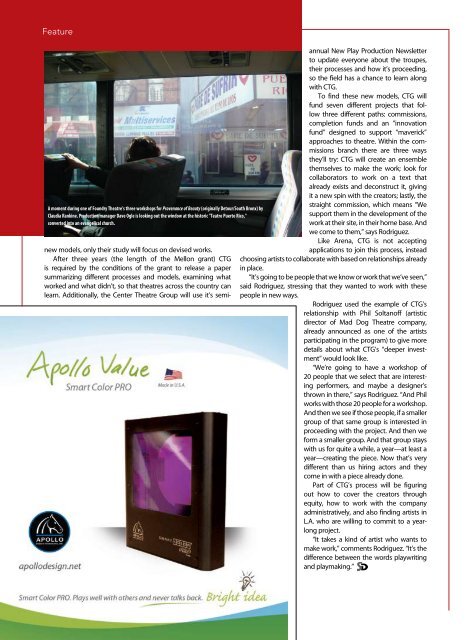Download a PDF - Stage Directions Magazine
Download a PDF - Stage Directions Magazine
Download a PDF - Stage Directions Magazine
You also want an ePaper? Increase the reach of your titles
YUMPU automatically turns print PDFs into web optimized ePapers that Google loves.
Feature<br />
A moment during one of Foundry Theatre’s three workshops for Provenance of Beauty (originally Detour/South Bronx) by<br />
Claudia Rankine. Production manager Dave Ogle is looking out the window at the historic "Teatro Puerto Rico,"<br />
converted into an evangelical church.<br />
new models, only their study will focus on devised works.<br />
After three years (the length of the Mellon grant) CTG<br />
is required by the conditions of the grant to release a paper<br />
summarizing different processes and models, examining what<br />
worked and what didn’t, so that theatres across the country can<br />
learn. Additionally, the Center Theatre Group will use it’s semiannual<br />
New Play Production Newsletter<br />
to update everyone about the troupes,<br />
their processes and how it’s proceeding,<br />
so the field has a chance to learn along<br />
with CTG.<br />
To find these new models, CTG will<br />
fund seven different projects that follow<br />
three different paths: commissions,<br />
completion funds and an “innovation<br />
fund” designed to support “maverick”<br />
approaches to theatre. Within the commissions<br />
branch there are three ways<br />
they’ll try: CTG will create an ensemble<br />
themselves to make the work; look for<br />
collaborators to work on a text that<br />
already exists and deconstruct it, giving<br />
it a new spin with the creators; lastly, the<br />
straight commission, which means “We<br />
support them in the development of the<br />
work at their site, in their home base. And<br />
we come to them,” says Rodriguez.<br />
Like Arena, CTG is not accepting<br />
applications to join this process, instead<br />
choosing artists to collaborate with based on relationships already<br />
in place.<br />
“It’s going to be people that we know or work that we’ve seen,”<br />
said Rodriguez, stressing that they wanted to work with these<br />
people in new ways.<br />
Rodriguez used the example of CTG’s<br />
relationship with Phil Soltanoff (artistic<br />
director of Mad Dog Theatre company,<br />
already announced as one of the artists<br />
participating in the program) to give more<br />
details about what CTG’s “deeper investment”<br />
would look like.<br />
“We’re going to have a workshop of<br />
20 people that we select that are interesting<br />
performers, and maybe a designer’s<br />
thrown in there,” says Rodriguez. “And Phil<br />
works with those 20 people for a workshop.<br />
And then we see if those people, if a smaller<br />
group of that same group is interested in<br />
proceeding with the project. And then we<br />
form a smaller group. And that group stays<br />
with us for quite a while, a year—at least a<br />
year—creating the piece. Now that’s very<br />
different than us hiring actors and they<br />
come in with a piece already done.<br />
Part of CTG’s process will be figuring<br />
out how to cover the creators through<br />
equity, how to work with the company<br />
administratively, and also finding artists in<br />
L.A. who are willing to commit to a yearlong<br />
project.<br />
“It takes a kind of artist who wants to<br />
make work,” comments Rodriguez. “It’s the<br />
difference between the words playwriting<br />
and playmaking.”

















